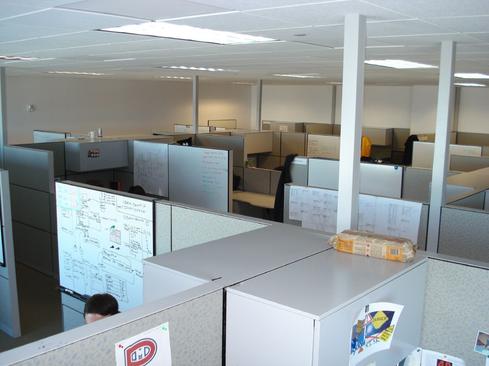VMware, EMC, Pivotal Launch 'Federated' Offerings
EMC, with subsidiaries RSA, VMware, and Pivotal, create integrated bundles in bid for deeper customer buy-in and lower support costs.


Cubicle Sins: 10 Coworkers Who Drive You Crazy
Cubicle Sins: 10 Coworkers Who Drive You Crazy (Click image for larger view and slideshow.)
VMware, EMC, Pivotal, and RSA launched Thursday the Federation Software-Defined Data Center Solution, a combined software stack for implementing an early version of a software-defined data center. Users get VMware vSphere and vCloud virtualization, EMC Viper storage management and storage devices, VMware NSX virtual networking, and RSA security.
No surprises there. These companies are all related by a common EMC ownership, so why wouldn't they integrate their products on a larger scale? Calling the group's first output the Federation Software-Defined Data Center Solution sounds a little grand, especially since four other "solutions" that any software-defined data center might need are still to come. Still, it sounds as if EMC wants to do to software what its VCE subsidiary did for virtualization hardware with Vblocks: Integrate in the lab and ship more valuable, modular units.
The upcoming Federation assemblies are: End User Computing Solution, Platform as a Service Solution, Virtualized Data Lakes Solution, and Security Analytics Solution. They are expected to emerge in that order, said Bharat Badrinath, senior director, EMC Global Solutions marketing, and Paul Strong, VP and CTO for VMware's Global Field organization, in an interview.
[EMC responded to rumors that it's considering selling its big stake in VMware. See EMC: VMware Not For Sale.]
Each software set will be integrated to work with the others so that the customer's IT staff would need to do minimal scriptwriting and configuration to get it up and running, something that's previously been left to IT staffs willing to undertake the task. The federated "solution" might seem to be a way to get customers to buy more products from companies they're already doing business with, and that would be a fair assessment. But there's a more subtle gain for EMC and partners if the Federated Solutions gain traction.
The solutions will standardize how many different products are assembled to work together. The testing of the integration will be handled by the vendor, not the customer's IT staff. As a result, each vendor's technical support team can have a more complete picture of how the combination works. Federation Lab's testing would indicate how the combination can be modified, added to, or otherwise fiddled with in ways that will cause it to break. The engineering that goes into creating the federated product has the potential to reduce technical support costs upon customer implementation.
Badrinath said work at the Federation Lab, which has been going on for a little over a year, amounts to 40,000 hours of software and hardware engineering. The Federation Software-Defined Data Center Solution can be used with a company's existing data center hardware or on a new set of hardware, as the customer sees fit.
The features of this software-defined data center are: automated provisioning of virtual machines, virtual networks, and storage; automated monitoring of their operation; metering of usage; backup and recovery services; disaster recovery service; connectivity to the public cloud -- probably VMware's vCloud Air Network; and hybrid cloud operation -- again, the likely candidate is Air Network.
"It's not just about features," said Badrinath. "It's about removing complexity, making these systems easy to access and reducing the time to value in consuming these infrastructure platforms."
"We're removing the variability from the integrations. We're investing upfront so we can reap the benefits down the pike" in more products sold with less technical support required, said Strong.
Strong and Badrinath say there is no new management interface planned for each "solution" at this time. Engineers are working with existing interfaces, particularly VMware's vSphere interface, to provide the management links for the set. However, Badrinath says it's possible a single management interface may one day be created to serve all five software stacks.
"Federation" is a word that comes to mind when describing combined user ID systems, such as a Federated Active Directory. But it may start to gain broader meaning as EMC, VMware, RSA, and Pivotal use the term to talk about their integrated products.
Since Pivotal and RSA are owned by EMC, with VMware 80% owned, they already represent a federation of companies, whether they integrate their products or not. And that's probably what enabled them to establish a Federation Lab on VMware's Palo Alto, Calif., campus. Badrinath and Strong declined to say how many technical staffers were assigned to work in the lab, and said part of its staff was "virtual" or drawn temporarily from different parts of each company.
Will customers want to buy such combinations -- all of them will amount to major entries from each company's product list -- even with the advantage of integration? Strong said there will be workflows, custom scripting, and configuration know-how built into each solution, but the firms will charge no more for the combination than they would have charged for the products separately.
The Federation Solutions should be a major topic at VMworld Europe, next week in Barcelona.
You've realized the easy gains from SaaS. Now it's time to dig into PaaS, performance, and more. Get the new Your Next Cloud Move issue of InformationWeek Tech Digest today. (Free registration required.)
About the Author
You May Also Like






